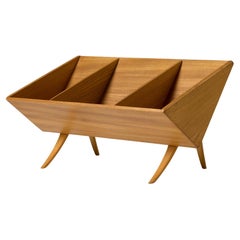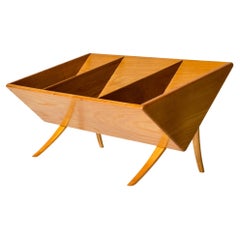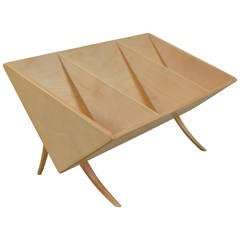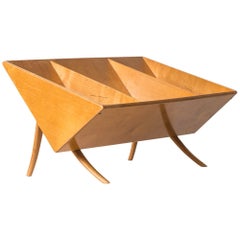Bruno Mathsson Book Crib
Vintage 1970s Swedish Scandinavian Modern Bookcases
Elm
Vintage 1960s Swedish Bookcases
Beech, Elm
Vintage 1930s Swedish Scandinavian Modern Magazine Racks and Stands
Elm
Recent Sales
Vintage 1960s Swedish Scandinavian Modern Bookcases
Birch
Vintage 1940s Swedish Scandinavian Modern Bookcases
Birch
Vintage 1940s Swedish Scandinavian Modern Bookends
Beech
Vintage 1940s Swedish Scandinavian Modern Bookcases
Beech, Elm
Vintage 1940s Swedish Scandinavian Modern Bookcases
Birch
Vintage 1960s Swedish Mid-Century Modern Bookends
Birch
Vintage 1940s Swedish Scandinavian Modern Magazine Racks and Stands
Birch
Vintage 1940s Swedish Scandinavian Modern More Desk Accessories
Birch
Vintage 1940s Swedish Scandinavian Modern Bookcases
Birch, Plywood
Vintage 1940s Swedish Scandinavian Modern Bookcases
Beech, Elm
Vintage 1950s Swedish Scandinavian Modern Bookcases
Birch, Ash
Vintage 1950s Swedish Scandinavian Modern Bookcases
Birch
Vintage 1940s Swedish Magazine Racks and Stands
Wood
Vintage 1940s Swedish Scandinavian Modern Bookcases
Elm
Vintage 1940s Swedish Scandinavian Modern Bookcases
Birch
People Also Browsed
Vintage 1920s Danish Scandinavian Modern Bookcases
Mahogany
Vintage 1950s Italian Mid-Century Modern Shelves and Wall Cabinets
Brass, Steel
Vintage 1950s Italian Mid-Century Modern Wardrobes and Armoires
Brass, Steel
Vintage 1950s French Mid-Century Modern Tables
Mahogany
Vintage 1950s Italian Mid-Century Modern Bookcases
Brass, Iron
Bruno Mathsson Book Crib For Sale on 1stDibs
How Much is a Bruno Mathsson Book Crib?
Bruno Mathsson for sale on 1stDibs
As the descendant of four generations of Swedish master cabinetmakers, Bruno Mathsson was born to design furniture. Mathsson was known as a methodical perfectionist who made usefulness the fundamental attribute of his iconic lounge chairs, tables, armchairs and other works, yet he was also a ceaseless experimenter, who constantly searched for improvements in form, materials and methods of design.
Like the Finnish designer Alvar Aalto, Mathsson was one of the first Scandinavians to embrace undulating, biomorphic forms in furniture. His early pieces such as the Eva and Pernilla series of chairs incorporate dramatically flowing bent beechwood frames, making them some of the most instantly recognizable works of 20th-century design.
Mathsson was also a pioneer of ergonomics — he is said to have based the contours of his chairs on the impression his body made when he sat in a snow bank — and used supple, accommodating woven webbing for seats. His concern for practicality is shown by pieces such as the Maria table. An elegant design with gate legs and hinged leaves, the table measures more than nine feet long when fully extended, but folds down to just nine inches in thickness.
From the mid-1940s through the 1950s, Mathsson focused on architecture, designing and building houses with insulated, triple-glazed window walls and heated floors — construction that flew in the face of traditional wood-clad Swedish residential design, and consequently met with some skepticism. He returned to furniture in the 1960s, employing an entirely new suite of materials: Stainless-steel framing and mesh seats feature in pieces like the Jetson chair; with the mathematician Piet Hein, Mathsson designed the Super-Elliptical table, which has a laminate top and four-part tubular steel legs that sprout like flower stems from a single base.
Bruno Mathsson’s stylistic flexibility as a designer made him a creator whose pieces meet all tastes and needs.
Find vintage Bruno Mathsson dining tables, seating and other furniture on 1stDibs.
A Close Look at Scandinavian Modern Furniture
Scandinavian modernism is perhaps the warmest and most organic iteration of modernist design. The work of the designers associated with vintage Scandinavian modern furniture was founded on centuries-old beliefs in both quality craftsmanship and the ideal that beauty should enhance even the humblest accessories of daily life.
ORIGINS OF SCANDINAVIAN MODERN FURNITURE DESIGN
- Emerged in the 1930s
- Scandinavian design and Nordic design originated primarily in Denmark, Sweden, Finland, Iceland and Norway
- Introduced in the United States in mid-20th century
- Informed by the Bauhaus; influenced American mid-century modernism
CHARACTERISTICS OF SCANDINAVIAN MODERN FURNITURE DESIGN
- Bold, clean lines and simple, sturdy symmetries
- Use of natural materials — native woods such as pine, ash and beech
- Open, airy spaces
- Promotion of functionality
- Emphasis on craftsmanship; rooted in cabinetry profession and traditional construction techniques
- Minimal ornamentation (little to no embellishment)
- A neutral or light color palette owing to prominence of light woods
SCANDINAVIAN MODERN FURNITURE DESIGNERS TO KNOW
- Alvar Aalto
- Hans Wegner
- Kaare Klint
- Arne Jacobsen
- Greta Magnusson Grossman
- Finn Juhl
- Arne Vodder
- Verner Panton
ICONIC SCANDINAVIAN MODERN FURNITURE DESIGNS
VINTAGE SCANDINAVIAN MODERN FURNITURE ON 1STDIBS
The gentle, organic contours that are typical of Scandinavian design appear in the furnishings and decor created by Danish, Finnish and Swedish designers not as a stylistic gesture, but rather as a practical, ergonomic — and, as importantly, elegant — response to the human form.
Each nation produced exceptional talents in all areas of the applied arts, yet each had its forté. Sweden was home to Greta Magnusson Grossman and Bruno Mathsson — creators of the classic Grasshopper lighting series and Berlin daybed, respectively — but the country excelled most notably at ceramics. In the 1920s at the great Gustavsberg porcelain manufactory, Wilhelm Kåge introduced pieces in the Scandinavian style based on influences from folklore to Cubism; his skills were passed on to his versatile and inspired pupils Berndt Friberg and Stig Lindberg.
Likewise, Finland produced a truly ingenious Scandinavian modern furniture designer in the architect Alvar Aalto, a master at melding function and artistic form in works like the Paimio chair, created in collaboration with his first wife, Aino. Yet Finnish glassware was pre-eminent, crafted in expressive, sculptural designs by Tapio Wirkkala and Timo Sarpaneva.
The Danes excelled at chairs. Hans Wegner and Arne Jacobsen were exemplars of the country’s facility with wood, particularly teak.
Wegner created such iconic pieces as the Round chair and the Wishbone chair; Jacobsen — while the revolutionary architect and furniture innovator produced the best-selling plywood Ant chair — designed two classic upholstered pieces of the 1950s: the Swan chair and Egg chair. The list of great Danes could go on and on, including Finn Juhl, a stylistic maverick and maker of the bold Chieftain chair; Poul Kjaerholm, with his lean metal-and-rattan aesthetic; and Verner Panton, who introduced a vibrant Pop note into international design.
Today, decades after their heyday, the prolific, ever-evolving Scandinavian modernists continue to amaze and delight, and interior designers all over the world use their pieces to bring warmth to any given space.
On 1stDibs, you will note both instantly recognizable vintage Scandinavian modern chairs, sofas, rugs and tables — those that have earned iconic status over time — and many new discoveries.




